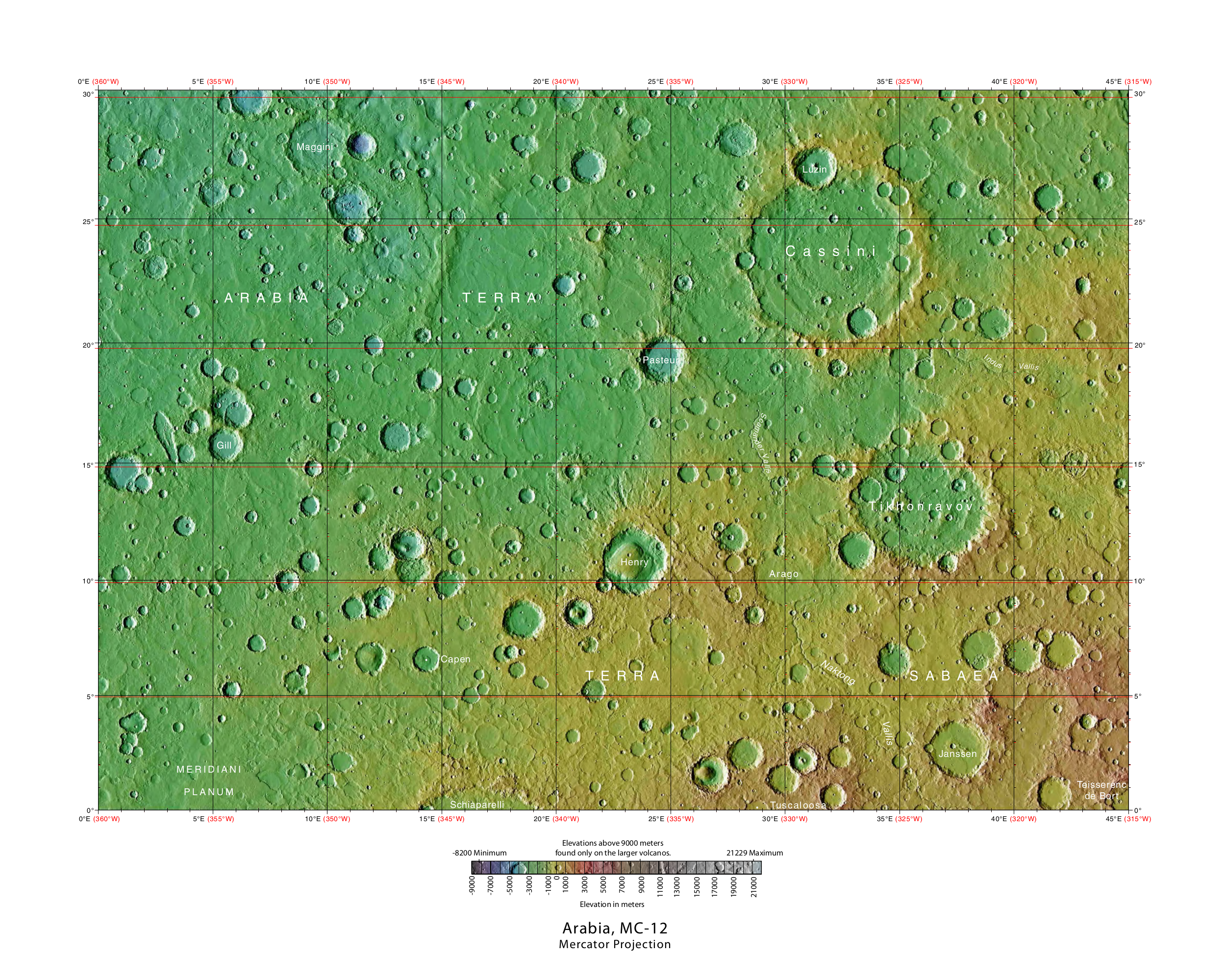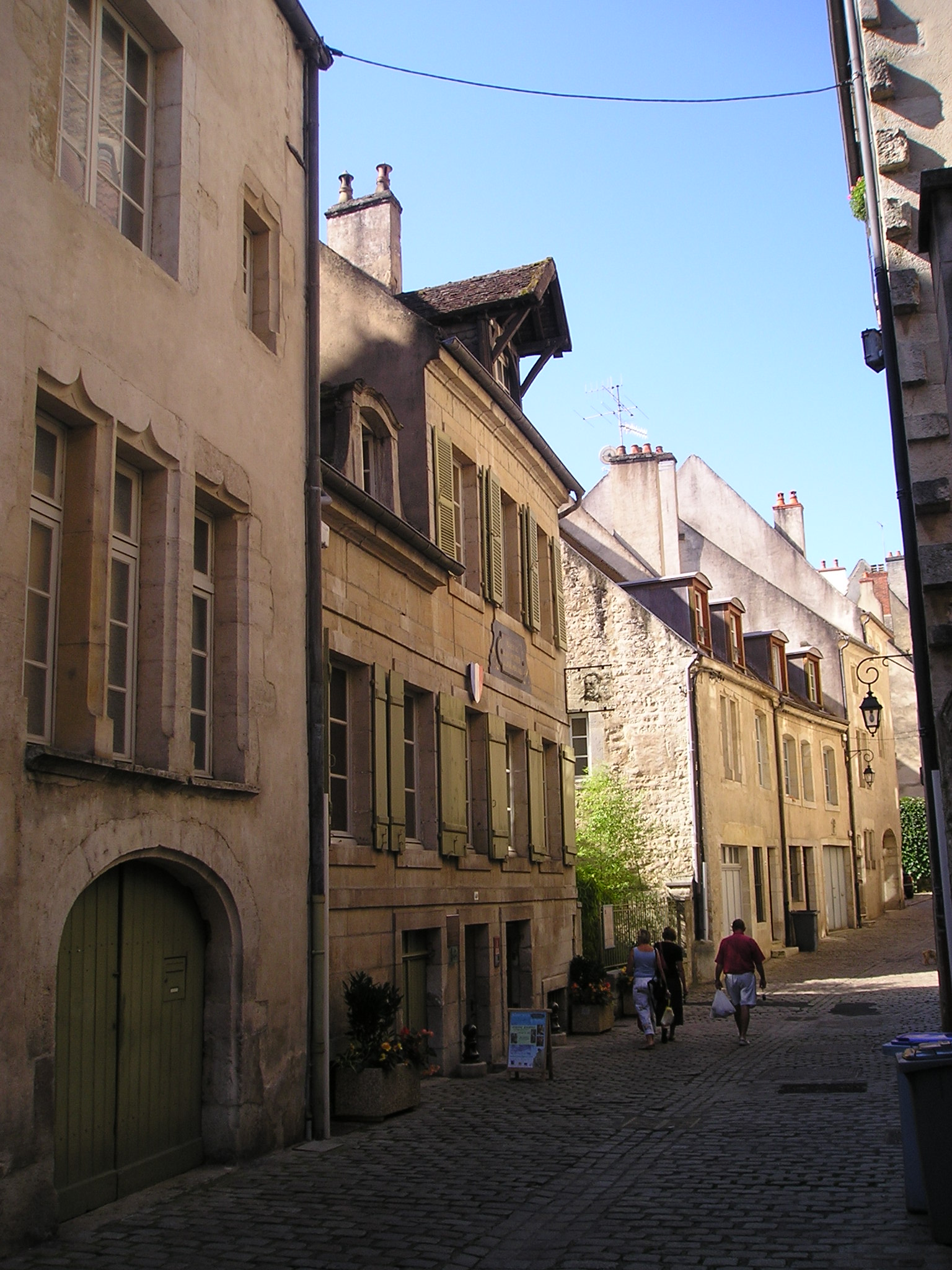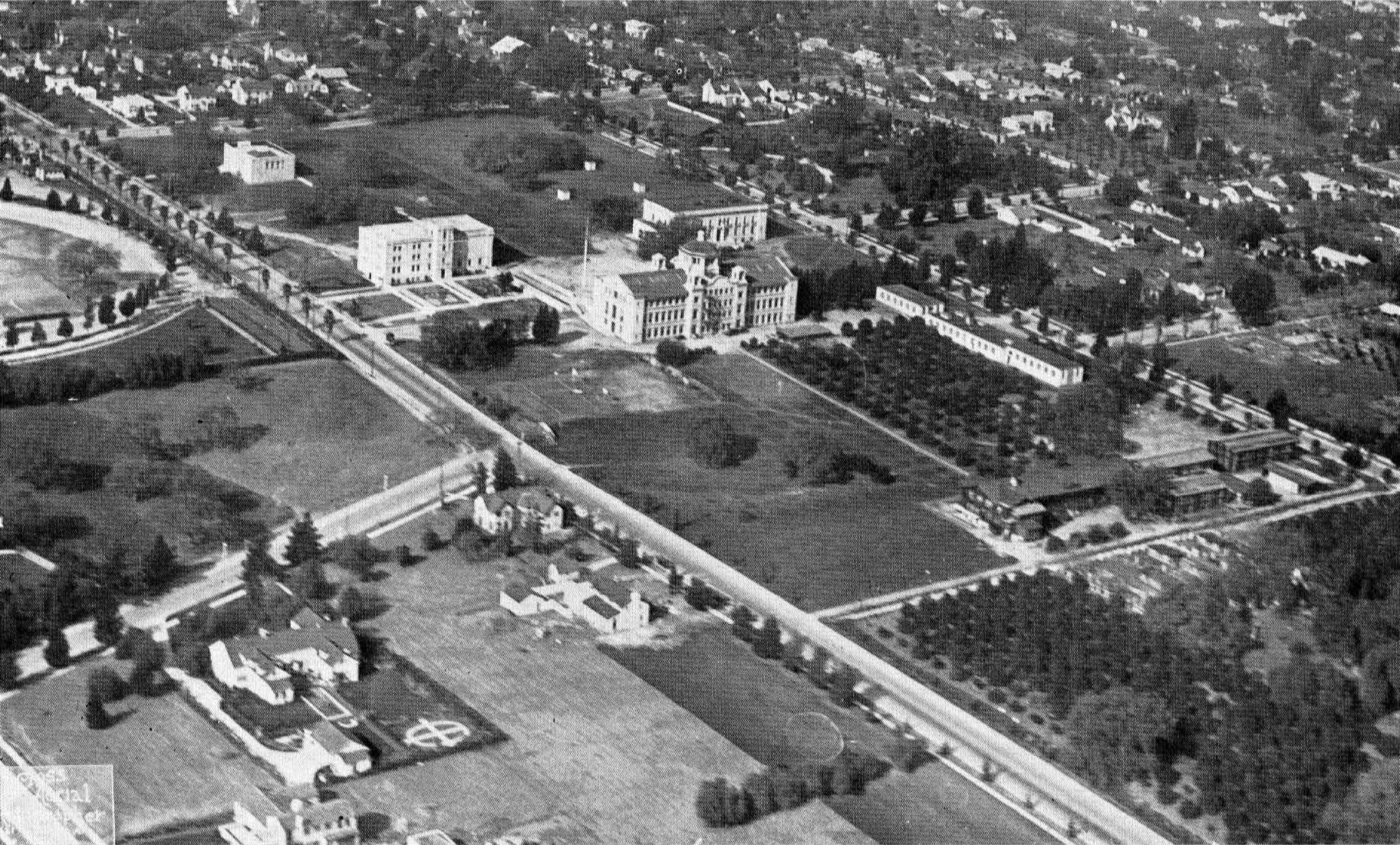|
Henry (Martian Crater)
Henry is a large crater in the Arabia quadrangle of Mars. It is in diameter and was named after the brothers Paul Henry and Prosper Henry, both of whom were French telescope makers and astronomers. Arago crater is to the east of Henry, Barth crater is to the southeast, and Pasteur crater is to the north. Layers Henry crater has a large mound in its center that shows layers in certain parts. The layers can be a few meters thick or tens of meters thick. Recent research on these layers by scientists at California Institute of Technology (Caltech) suggest that ancient climate change on Mars caused by regular variation in the planet's tilt, or obliquity may have caused the patterns in the layers. On Earth, similar changes (astronomical forcing) of climate results in ice-age cycles. In a recent study of layers in craters in western Arabia Terra much was learned about the layers. Each layer may average under 4 meters in one crater, but 20 meters in another. Although the c ... [...More Info...] [...Related Items...] OR: [Wikipedia] [Google] [Baidu] [Amazon] |
Arabia Quadrangle
The Arabia quadrangle is one of a series of list of quadrangles on Mars, 30 quadrangle maps of Mars used by the United States Geological Survey (USGS) Astrogeology Research Program. The Arabia quadrangle (geography), quadrangle is also referred to as MC-12 (Mars Chart-12). The quadrangle contains part of the classic area of Mars known as Arabia Terra, Arabia. It also contains a part of Terra Sabaea and a small part of Meridiani Planum. It lies on the boundary between the young northern plains and the old southern highlands. The quadrangle covers the area from 315° to 360° west longitude and 0° to 30° north latitude. Description The surface of the Arabia quadrangle appears to be very old because it has a high density of craters, but it is not near as high in elevation as typical old surfaces. On Mars the oldest areas contain the most craters; the oldest period is called Noachian after the quadrangle Noachis. The Arabia area contains many buttes and ridges. Some believe th ... [...More Info...] [...Related Items...] OR: [Wikipedia] [Google] [Baidu] [Amazon] |
Mars
Mars is the fourth planet from the Sun. It is also known as the "Red Planet", because of its orange-red appearance. Mars is a desert-like rocky planet with a tenuous carbon dioxide () atmosphere. At the average surface level the atmospheric pressure is a few thousandths of Earth's, atmospheric temperature ranges from and cosmic radiation is high. Mars retains some water, in the ground as well as thinly in the atmosphere, forming cirrus clouds, frost, larger polar regions of permafrost and ice caps (with seasonal snow), but no liquid surface water. Its surface gravity is roughly a third of Earth's or double that of the Moon. It is half as wide as Earth or twice the Moon, with a diameter of , and has a surface area the size of all the dry land of Earth. Fine dust is prevalent across the surface and the atmosphere, being picked up and spread at the low Martian gravity even by the weak wind of the tenuous atmosphere. The terrain of Mars roughly follows a north-south ... [...More Info...] [...Related Items...] OR: [Wikipedia] [Google] [Baidu] [Amazon] |
Impact Crater
An impact crater is a depression (geology), depression in the surface of a solid astronomical body formed by the hypervelocity impact event, impact of a smaller object. In contrast to volcanic craters, which result from explosion or internal collapse, impact craters typically have raised rims and floors that are lower in elevation than the surrounding terrain. Impact craters are typically circular, though they can be elliptical in shape or even irregular due to events such as landslides. Impact craters range in size from microscopic craters seen on lunar rocks returned by the Apollo Program to simple bowl-shaped depressions and vast, complex, multi-ringed impact basins. Meteor Crater is a well-known example of a small impact crater on Earth. Impact craters are the dominant geographic features on many solid Solar System objects including the Moon, Mercury (planet), Mercury, Callisto (moon), Callisto, Ganymede (moon), Ganymede, and most small moons and asteroids. On other planet ... [...More Info...] [...Related Items...] OR: [Wikipedia] [Google] [Baidu] [Amazon] |
Paul Henry And Prosper Henry
Paul-Pierre Henry (21 August 1848 – 4 January 1905) and his brother Prosper-Mathieu Henry (10 December 1849 – 25 July 1903) were French opticians and astronomers. They made refracting telescopes and instruments for observatories, and were involved in the origin of the ''Carte du Ciel'' project. Between the two of them, they discovered a total of 14 asteroids. The Minor Planet Center credits their discoveries under "P. P. Henry" and "P. M. Henry", respectively. The lunar crater Henry Frères (Henry brothers) and the Martian crater ''Henry'' are named after them. They were jointly awarded the first Valz Prize in 1877 for their sky charts designed to facilitate the search for minor planets According to the International Astronomical Union (IAU), a minor planet is an astronomical object in direct orbit around the Sun that is exclusively classified as neither a planet nor a comet. Before 2006, the IAU officially used the term ''minor .... List of discovered minor planets ... [...More Info...] [...Related Items...] OR: [Wikipedia] [Google] [Baidu] [Amazon] |
Arago (Martian Crater)
Arago is an impact crater in the Arabia quadrangle on Mars at 10.22 N and 29.93° E. It is in diameter and is in the northernmost part of Terra Sabaea. Its name was approved in 1973 and refers to the French astronomer François Arago. Arago is highly eroded and subdued and is thus ancient. Arago is believed to have once held a giant lake that drained into the Naktong-Scamander-Mamers lake-chain system.Fassett, C. and J. Head III. 2008. "Valley network-fed, open-basin lakes on Mars: Distribution and implications for Noachian surface and subsurface hydrology". ''Icarus'': 198. 39-56. Naktong Vallis is to the south of Arago and Scamander Vallis is to the north. Water flowed from the south to the north and pooled in Arago and also in the larger Tikhonravov crater to the northeast of Arago. Henry Henry may refer to: People and fictional characters * Henry (given name), including lists of people and fictional characters * Henry (surname) * Henry, a stage name of François-L ... [...More Info...] [...Related Items...] OR: [Wikipedia] [Google] [Baidu] [Amazon] |
Barth (crater)
Barth may refer to: Places * Barth, Germany, a town in Mecklenburg-Western Pomerania, Germany ** Barth (Amt), administrative subdivision * Barth Island, Nunavut, Canada Other uses * Barth (name), a surname (and list of people with that name) * Barth Bagge, a character from the television show "You Can't Do That on Television ''You Can't Do That on Television'' is a Canadian sketch comedy television series that aired locally in 1979 before airing in the United States in 1981. It featured adolescent and teenage actors performing in a sketch comedy format similar to A ..." * Barth Classic, a golf tournament on the LPGA Tour from 1974 to 1980 See also * Barth syndrome, a metabolic disorder * Barthes (other) * Barthe (other) {{disambig, geo ... [...More Info...] [...Related Items...] OR: [Wikipedia] [Google] [Baidu] [Amazon] |
Pasteur (Martian Crater)
Louis Pasteur (, ; 27 December 1822 – 28 September 1895) was a French chemist, pharmacist, and microbiologist renowned for his discoveries of the principles of vaccination, microbial fermentation, and pasteurization, the last of which was named after him. His research in chemistry led to remarkable breakthroughs in the understanding of the causes and preventions of diseases, which laid down the foundations of hygiene, public health and much of modern medicine. Pasteur's works are credited with saving millions of lives through the developments of vaccines for rabies and anthrax. He is regarded as one of the founders of modern bacteriology and has been honored as the "father of bacteriology" and the "father of microbiology" (together with Robert Koch; the latter epithet also attributed to Antonie van Leeuwenhoek). Pasteur was responsible for disproving the doctrine of spontaneous generation. Under the auspices of the French Academy of Sciences, his experiment demonstr ... [...More Info...] [...Related Items...] OR: [Wikipedia] [Google] [Baidu] [Amazon] |
California Institute Of Technology
The California Institute of Technology (branded as Caltech) is a private research university in Pasadena, California, United States. The university is responsible for many modern scientific advancements and is among a small group of institutes of technology in the United States that are devoted to the instruction of pure and applied sciences. The institution was founded as a preparatory and vocational school by Amos G. Throop in 1891 and began attracting influential scientists such as George Ellery Hale, Arthur Amos Noyes, and Robert Andrews Millikan in the early 20th century. The vocational and preparatory schools were disbanded and spun off in 1910, and the college assumed its present name in 1920. In 1934, Caltech was elected to the Association of American Universities, and the antecedents of NASA's Jet Propulsion Laboratory, which Caltech continues to manage and operate, were established between 1936 and 1943 under Theodore von Kármán. Caltech has six academic divisi ... [...More Info...] [...Related Items...] OR: [Wikipedia] [Google] [Baidu] [Amazon] |
Becquerel (Martian Crater)
Becquerel is a 167 km-diameter crater at 22.1°N, 352.0°E on Mars, in Arabia Terra in Oxia Palus quadrangle. It is named after Antoine H. Becquerel. Photographs by the Mars Global Surveyor revealed layered sedimentary rocks in the crater. The layers appear to be only a few meters thick and show little variations in thickness. Recent studies with HiRISE have determined the exact thickness of the layers. The 66 layers measured showed one group of layers to average and another group to average in thickness. Patterns like this are usually produced on Earth through the effects of water; volcanic deposits would not produce ash or laval flows of such regular thickness and in any event, there are no nearby volcanic vents. There are cyclic variations in the thickness of the exposed sedimentary layers, possibly indicating cyclic variations in environmental conditions while the sediment was being laid down. Most of the layers are parallel to each other, suggesting they formed ... [...More Info...] [...Related Items...] OR: [Wikipedia] [Google] [Baidu] [Amazon] |
Carbon Dioxide
Carbon dioxide is a chemical compound with the chemical formula . It is made up of molecules that each have one carbon atom covalent bond, covalently double bonded to two oxygen atoms. It is found in a gas state at room temperature and at normally-encountered concentrations it is odorless. As the source of carbon in the carbon cycle, atmospheric is the primary carbon source for life on Earth. In the air, carbon dioxide is transparent to visible light but absorbs infrared, infrared radiation, acting as a greenhouse gas. Carbon dioxide is soluble in water and is found in groundwater, lakes, ice caps, and seawater. It is a trace gas Carbon dioxide in Earth's atmosphere, in Earth's atmosphere at 421 parts per million (ppm), or about 0.042% (as of May 2022) having risen from pre-industrial levels of 280 ppm or about 0.028%. Burning fossil fuels is the main cause of these increased concentrations, which are the primary cause of climate change.IPCC (2022Summary for pol ... [...More Info...] [...Related Items...] OR: [Wikipedia] [Google] [Baidu] [Amazon] |
Mars Reconnaissance Orbiter
The ''Mars Reconnaissance Orbiter'' (''MRO'') is a spacecraft designed to search for the existence of water on Mars and provide support for missions to Mars, as part of NASA's Mars Exploration Program. It was launched from Cape Canaveral on August 12, 2005, at 11:43 UTC and reached Mars on March 10, 2006, at 21:24 UTC. In November 2006, after six months of aerobraking, it entered its final science orbit and began its primary science phase. Mission objectives include observing the climate of Mars, investigating geologic forces, providing reconnaissance of future landing sites, and relaying data from surface missions back to Earth. To support these objectives, the ''MRO'' carries different scientific instruments, including three cameras, two spectrometers and a subsurface radar. As of July 29, 2023, the ''MRO'' has returned over 450 terabits of data, helped choose safe landing sites for NASA's Mars landers, discovered pure water ice in new craters and further evidence that ... [...More Info...] [...Related Items...] OR: [Wikipedia] [Google] [Baidu] [Amazon] |
Opportunity Rover
''Opportunity'', also known as MER-B (Mars Exploration Rover – B) or MER-1, and nicknamed Oppy, is a Robotics, robotic rover (space exploration), rover that was active on Mars from 2004 until 2018. ''Opportunity'' was operational on Mars for Timekeeping on Mars#Sols, sols ( on Earth). Launched on July 7, 2003, as part of NASA's Mars Exploration Rover program, it landed in Meridiani Planum on January 25, 2004, three weeks after its twin, ''Spirit (rover), Spirit'' (MER-A), touched down on the other side of the planet. With a planned 90-Sol (day on Mars), sol duration of activity (slightly less than 92.5 Earth days), ''Spirit'' functioned until it got stuck in 2009 and ceased communications in 2010, while ''Opportunity'' was able to stay operational for sols after landing, maintaining its power and key systems through continual recharging of its batteries using solar power, and hibernating during events such as dust storms to save power. This careful operation allowed ''Opport ... [...More Info...] [...Related Items...] OR: [Wikipedia] [Google] [Baidu] [Amazon] |








